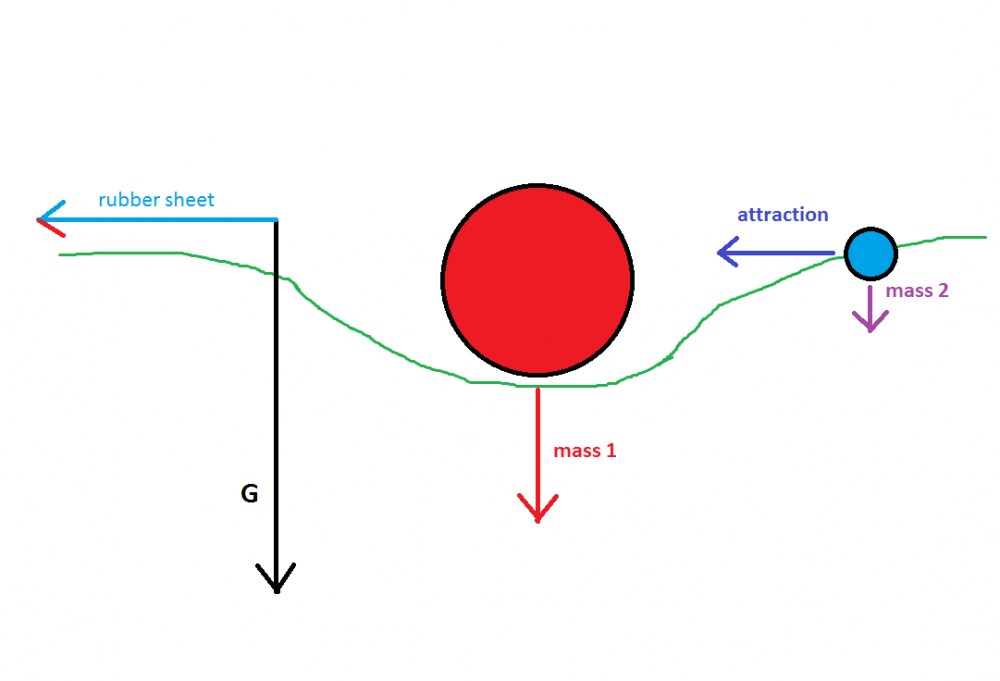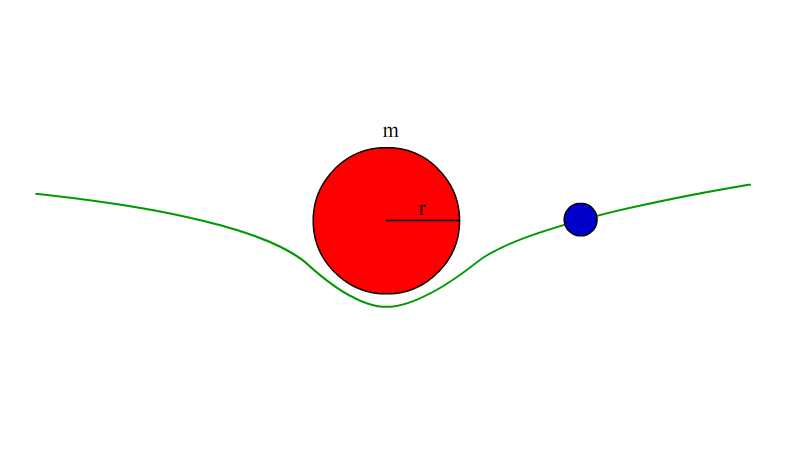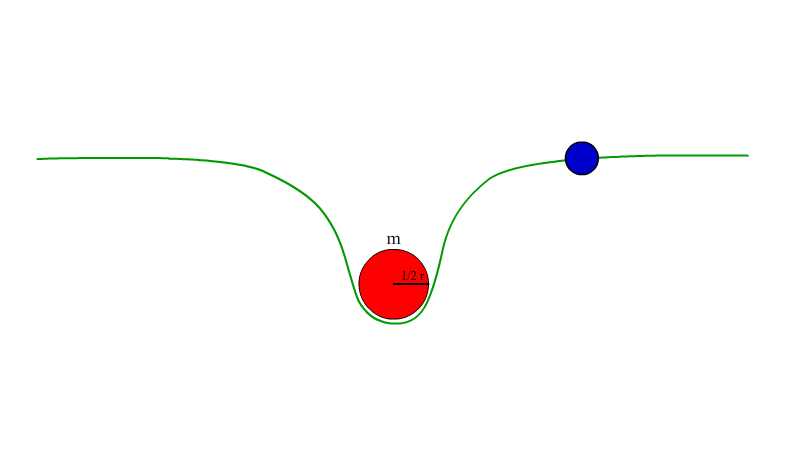-
Posts
94 -
Joined
-
Last visited
Content Type
Profiles
Forums
Events
Everything posted by Unified Field
-

Size & Gravity - Is General Relativity Incorrect?
Unified Field replied to Unified Field's topic in Speculations
Problem is, that Newton's equation requires the constant value of G to work. But there's no G beyond the g. field of Earth True... But maybe we should? 10kg of mass should induce different force of attraction, when it's exist in a form of a metal ball and a form of gas cloud... It's you, who think, that it's irrevelant. But in this subject, state of matter has significant role in interactions between objects. If I throw a 10kg piece of steel, it will pass through 10kg of gas and it will slow down just a tiny bit. However in 10kg of water, 10kg of steel, will slow down visibly. But when two 10kg solid bodies collide directly, they loose their momentum completely. What is the distribution of matter at different states in a g. field? What kind of matter is in the center and what is placed on the outside of mass concentration? <copied> Ok, then why Solar System orbit around the center of galaxy and not around another star system, which has higher mass and is placed closer to Sun, than the galaxy center? Exactly! This is why I like to speak with people, who have proper knowledge - each time I learn new things... I don't say, that gas doesn't give back any force - but we need to include the size of a body, during those interactions. When we push a solid object in one spot, we push it as a whole body, but in a gas or liquid, we push only part of the mass - and only this part is pushing us back. And now imagine, that a solid body is attracted by the gravitation of a gas cloud - what will happen, if they collide? Simply - solid body will pass through and locate itself in the center of mass. However I would say, that it will be rather the gas, which would "wrap itself" around the solid object... -

Size & Gravity - Is General Relativity Incorrect?
Unified Field replied to Unified Field's topic in Speculations
If I will push a cloud of gas, which has the same mass, as I have, I won't experience the force of the push, directed towards me. I would have to close the cloud in a container, to make it work - or turn myself into a flat surface, to interact with the gas, as a single object... Ok, then why Solar System orbit around the center of galaxy and not around another star system, which has higher mass and is placed closer to Sun, than the galaxy center? -

Size & Gravity - Is General Relativity Incorrect?
Unified Field replied to Unified Field's topic in Speculations
Generally, thanks for your input Mordred. I really appreciate, when someone is discussing actual science, instead simply telling me, how stupid I am... -

Size & Gravity - Is General Relativity Incorrect?
Unified Field replied to Unified Field's topic in Speculations
It doesn't matter for the bodies attracted from the outside If the body is a spherically symmetric shell (i.e., a hollow ball), no net gravitational force is exerted by the shell on any object inside, regardless of the object's location within the shell. Inside, there's no attraction towards the center. Actually this confirms, what I said... Thanks I would only add one thing - there will be attraction towards the center inside a hollow sphere, if we put there an object with bigger mass, than the entire sphere and with bigger density - only then, the hollow sphere will be attracted stronger towards this object, than the other way... That's a nice question I think, that in both directions it will start to weaken and finally disappear completely. I was thinking about it yesterday - what would happen, if we would make a tunnel through the core of Earth? I guess, that at some distance from the center, we would enter a 0-g area. But maybe I'm wrong? Maybe we would start getting heavier, the closer to the center we would move? -

Size & Gravity - Is General Relativity Incorrect?
Unified Field replied to Unified Field's topic in Speculations
That's what I was thinking about - it just has to be rather precise... Poisson's equations are being used in both cases... If you have one, I will buy it... "Similar" doesn't mean "exactly the same" - it means, that they just have some things in common... Newton's law of gravitation works nicely on Earth - but how it works beyond the g. field of Earth? Because there's a lot of concentrated mass below them....? -

Size & Gravity - Is General Relativity Incorrect?
Unified Field replied to Unified Field's topic in Speculations
Newton laws work with solid bodies. In the case of liquids and gases, we use different rules... Cloud of gas is a body, but can you push it as a single object with your hand? Yes - if entire Solar System is attracted towards the galaxy center, then why planets are attracted towards the Sun and not towards the galaxy? Or how galaxies interact with eachother as single objects and not as separate star systems? It's the SIZE of a field, which matters... -

Size & Gravity - Is General Relativity Incorrect?
Unified Field replied to Unified Field's topic in Speculations
It depends on the medium. Turning ice into water vapor won't change the attraction on the moon (possibly?), but it will have significant meaning within an atmosphere. -

Size & Gravity - Is General Relativity Incorrect?
Unified Field replied to Unified Field's topic in Speculations
But distribution of mass in space IS the density. -

Size & Gravity - Is General Relativity Incorrect?
Unified Field replied to Unified Field's topic in Speculations
Not in it's inside - particles inside an uniform object (or a medium) don't experience any attraction, no matter, what is their state. But their concentration (or state) will affect the force, with which other bodies will be attracted. If we turn the Sun into a nebula (keeping it's mass), particles within the cloud won't experience any gravity, but it will affect the attraction of all the planets in Solar System... -

Size & Gravity - Is General Relativity Incorrect?
Unified Field replied to Unified Field's topic in Speculations
If electrostatic charge depends on the concentration of charged particles, then why gravity shouldn't? If I would want to reach Earth's core with a projectile, I would concentrate as much mass, as I can, in the smallest possible space. If I would get 10000 tonnes concentrated in a small marble and dropped it on Earth's surface, it could possibly reach the center of planet - but the bigger would be the size, the more force I would need to get through the crust... Did you ever heard about stars or planets, which are orbiting around clouds of interstellar gas? In which direction the attraction is stronger - of a planet towards the cloud, or cloud towards the planet? I would choose the secon option, even if the cloud would have bigger mass, than planet... -

Size & Gravity - Is General Relativity Incorrect?
Unified Field replied to Unified Field's topic in Speculations
Yes, its the distribution of those particles that matter. But also their atomic mass - atom of lead has much more mass and is much densier, than hydrogen. Exactly! And this is why I said this: "If there would be a planetary body, made of liquid water and nothing else, there shouldn't be no pressure towards the center...". Motion and force appear, when there's a differential of any kind - as in nature every difference wants to be nullified. You can as well change the volume and for example compress the particles over smaller space - but it will work only in the case of gases (possibly plasma?). It would be rather hard, if not impossible to compress a rocky planet. You can as well change the energy level of particles, what affects the state of matter and it's distribution, without affecting the mass. -

Size & Gravity - Is General Relativity Incorrect?
Unified Field replied to Unified Field's topic in Speculations
Yes, except the part, which tells, that gravity is oriented towards the center of mass - it won't work, if you're inside a hollow sphere... In an object, which is made of an uniform material, mass is distributed equally, if there's no influence of an external g. field (at least in a sphere)... If there would be a planetary body, made of liquid water and nothing else, there shouldn't be no pressure towards the center... -

Size & Gravity - Is General Relativity Incorrect?
Unified Field replied to Unified Field's topic in Speculations
Ok, but it is also a source of force directed towards it. Outside the g. field of Earth this force can be measured. If every particle of matter is a source of this force, then it's obvious, that the larger is the number of particles in a specified area, the stronger is the force... -

Size & Gravity - Is General Relativity Incorrect?
Unified Field replied to Unified Field's topic in Speculations
Yes. Weight is a force, produced by gravity of Earth. But doesn't density correlate with momentum? https://www.quora.com/How-are-momentum-and-density-related It's harder to stop a bullet, than a beach ball at similar mass... -

Size & Gravity - Is General Relativity Incorrect?
Unified Field replied to Unified Field's topic in Speculations
And this is, what makes me wonder - how it's possible, that no one didn't think about it. I mean, it's something rather obvious, that a force behaves differently, when it's concentrated in a single point and when it's distributed over some area. If a black hole can be compared to a hole in the rubber sheet, then it's logical, that it's MUCH easier to puncture the material (or fabric of the time-space) with a nail, than with a hammer. You don't need to be a genius, to figure it out... It's the OBJECT, what creates a g. field, not it's center of mass. Inside the object, there's no attraction towards the center and matter is "floating" freely. However a force will appear, if another body will be placed inside the central object - this force can be directed outwards or towards the center of mass, depending on the DENSITY of a body. It's the density, which determines, if object will fall, or will fly up. The most dense objects are always placed in the center of a body and the concentration of matter gets smaller towards the outside. Buoyancy and gravity are created by the same force, which depends on the density, not mass... -

Size & Gravity - Is General Relativity Incorrect?
Unified Field replied to Unified Field's topic in Speculations
Exactly. I don't need sophisticated equipement and 4D geometry equations. I would "borrow" a Newton scale from school, but I'm not a student anymore - so I will have to buy one. I think, that everything can be done, using calculations on vectors... Something like this... -

Size & Gravity - Is General Relativity Incorrect?
Unified Field replied to Unified Field's topic in Speculations
Ok... I wanted to start with measuring the force of attraction of a body in 4 scenarios: 1. r and m 2. r and 2*m 3. 2*r and m 4. 2*r and 2*m Where r is for radius of a central body and m is for it's mass... Then I wanted to calculate the results, using standard equations and compare them with measured results. I don't need the exact values, only the ratio, how much stronger should be the force, when mass of central body is 2 times so high. I think, that the best would be to measure all 4 scenarios twice - for close and distant locations of attracted body. And finally create a formula, which would express the correlation between size and attraction... -

Size & Gravity - Is General Relativity Incorrect?
Unified Field replied to Unified Field's topic in Speculations
Thanks! -

Size & Gravity - Is General Relativity Incorrect?
Unified Field replied to Unified Field's topic in Speculations
First I need to figure out something to measure the inward force - I don't own a laboratory. Then I can calculate, how this force differs, depending on the size of central object... But still the same equations are being used in both cases... Yes. But it doesn't mean, that 4D won't behave in similar way... There are many reasons, why I can assume it... -

Size & Gravity - Is General Relativity Incorrect?
Unified Field replied to Unified Field's topic in Speculations
Rubber sheet shows incorrect outcome, when it comes to simulate orbits of bodies, which are moving around the center of gravity, but can be used without any problems, to visualise the shape of space-time curvatures. -

Size & Gravity - Is General Relativity Incorrect?
Unified Field replied to Unified Field's topic in Speculations
"The height as a function of position of the elastic sheet is a solution to Poisson's equation, which is the same equation that gives you the (classical) gravitational potential. So the demonstration is an analogue computation that solves the analogous problem in gravity" Exactly the same calculations are being used for the rubber sheet and the space-time curvature. Curvature of rubber sheet is fully consistent with the expected curvature of space-time. -
According to science, there's absolutely no correlaton between the size of an object and the gravitational field, which it produces. Science tells, that changing the size of Sun wouldn't have no effect on the planets in Solar System. I don't agree with this. I think, that density of an object has significant importance for the properties of g. field, which it produces. What makes me thinks this way? Well, I've noticed, that celestial objects, which have low density, like a nebula, don't attract other objects with the same force, as planets or stars. If density of objects has no influence on gravity, then try this: - take a beach ball and a golf ball with similar masses - throw them both into a pond - think... I say, that big objects attract matter at larger distance, than small objects, but the force of attraction is weaker. Mass concentrated in small area generates a g. field with higher magnitude, but distributed over smaller space. Mass scattered over large area generates bigger, but weaker g. field. It should be rather obvious, that objects with higher concentration of mass, create different curvatures of "space-time", than objects with low density of matter. Those two images show, what according to me, is the difference of "space-time curvatures", for 2 objects with the same mass, but different sizes: And this is, what makes the difference, between those images and the mainstream science: According to science, force of attraction is always directed towards the center of mass. According to me, force is directed towards the object, which is the source of g. field. Such difference seems to be insignificant, but it changes a lot. Imagine, that Earth is hollow - what would be the direction of attraction for objects, which are placed inside the planet? Science say, that towards the center. I say, that towards the inner surface... I will now use the rubber sheet model of "space-time", to compare the difference between a force, which is concentrated in a point and a force, which is distributed over some area: In the rubber sheet model, mass of objects works, as a force directed downwards - thanks to the gravity of Earth. Force and mass can be used in this case as the same variable value. This allows me to compare the distance, at which objects with different sizes attract other bodies, when a force is applied: Of course, I'm aware, that this experiment is far from perfect and can't be used, to collect any valuable readings. However, it should be rather clear, that force, which is distributed over larger area, attracts objects at bigger distances, than force, which is concentrated in a single point. If you are interested in some actual readings and real values, you should recreate this experiment in a laboratory - because sadly I don't have necessary equipement. If you think, that I alternated the results in any way, I suggest you to make this experiment by yourself (it shouldn't be too complicated). If your results will contradict somehow my claims, feel free to present your evidence in this thread. In my next movie, I will compare the force of attraction of an heavy and small object with an lighter, but bigger object - it's already recorded, but first I want to hear, what can you say about this part...
- 57 replies
-
-1
-
Ok, so I can't use the rubber sheet model, to calculate the actual properties of orbits for objects, which are moving around a central object - don't worry, I don't want to... I have already a model, which represent's the gravity in better way. But you are still not able, to understand it - that's why, I have to use your theories, to prove, that you are incorrect All I need, is to observe, how the size of an object affects the curvature of "space-time" - and according to all possible sources of official science I have full right to use the only possible way to visualize gravitational field in space. Tell me, why I shouldn't do it?
-
Maybe - but it doesn't mean, that I can't check, if the same equation won't work for real g.fields. There are many equations, which can be used in different scenarios GR has many aspects - by proving one of them, you don't prove all others... Because to get such result, I need to make a proper measurement, because as for today science didn't try to prove this part of GR
-
Ok, but why I can't use it, to formulate an equation? If the model represents correctly all the correlations between variable values, I should be able to create a formula, which then can be tested in gravitational fields... Because I need to include the distance, at which objects with different densities start to interact with eachother... I think, that this: "The height as a function of position of the elastic sheet is a solution to Poisson's equation, which is the same equation that gives you the (classical) gravitational potential. So the demonstration is an analogue computation that solves the analogous problem in gravity" is enough, to know, that I can use the model and no one won't tell, that it shows completely incorrect results... However, I can see already, that some "scientists" will try... Your "evidence" exists only in the form of an equation - I don't consider it, as emprical proof of anything....




